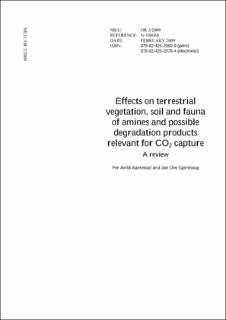Effects on terrestrial vegetation, soil and fauna of amines and possible degradation products relevant for CO2 capture. A review.
Research report
Permanent lenke
https://hdl.handle.net/11250/2718677Utgivelsesdato
2009Metadata
Vis full innførselSamlinger
Sammendrag
This report gives an overview of the minor knowledge that exists on effects of amines, used in capturing carbon dioxide, and their main degradation products on terrestrial vegetation and fauna. Amines such as MEA, MDEA, AMP and Piperazine and several of their degradation products act as growth stimulating medium for plants, and most biodegrade easily in soils to plant available nitrogen. Deposited in the environment they might contribute to eutrophication of terrestrial ecosystems, leading to increased growth of grasses, reduced plant diversity and changes in soil nutrients and soil fauna. Amines are skin-irritating and toxic to animalsat high concentrations, and several of their degradation products, such as nitrosamines and nitramines, are known to be carcinogenic to mammals, reptiles and amphibians, probably also toxic to soil fauna and soil microorganisms. Piperazine is probably the most unfavourable amine. There is a great need for new research on environmental effects of relevant amines and their degradation products in order to run carbon dioxide capture plants with minor negative effects on the environment.
